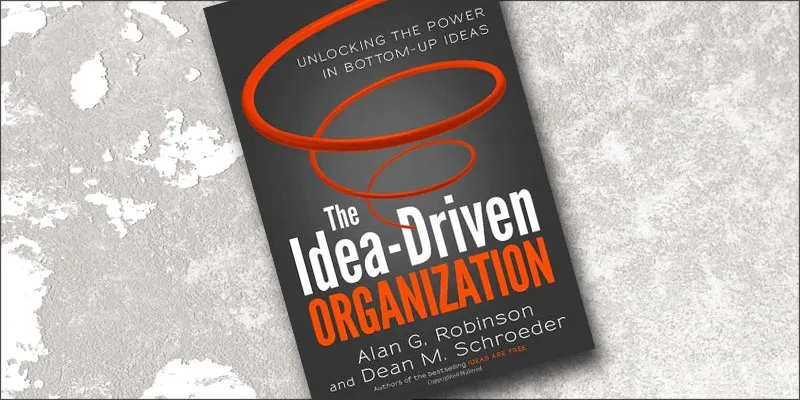From ideas to implementation: how startups can sustain their innovation edge
Globalisation, rapid economic growth in emerging economies, and the rise of the Internet are forcing organisations to increase the rate at which they innovate and improve. Even startups face the risk of losing their innovation edge as they grow and scale, unless they take extra steps to protect and promote their idea pipeline.
How to sustain the flow and implementation of ideas is the key focus of the new book, The Idea-Driven Organisation: Unlocking the Power of Bottom-Up Ideas, by Alan Robinson and Dean Schroeder.

The book maintains that good ideas come not just top-down from managers but also bottom-up in the organisation, keeping creativity and productivity flowing. Having a steady and free flow of ideas helps create a high-performing organisation.“Every day, frontline employees see many problems and opportunities that their managers do not,” the authors begin. Managers may be skilled in aggregate knowledge, but are often shielded from operational and customer-facing innovations. They tend to focus largely on the big numbers, but miss out on the rich sources of insights on the frontlines.
Many books address how creative companies such as Apple and Amazon are – but it is another task altogether to become creative like them. The authors recommend that leaders structure their company for ideas, align budgets and rewards for ideas, implement a high-performing idea system via training and piloting, and evolve to become problem-finding organisations. I have summarised some of these key steps in Table 1, with more examples below from a wide range of sectors.
Table 1: Creating Idea-Driven Organisations
Idea management is much more than asking people for ideas – it is about giving employees clues on what kinds of ideas are needed, training them on how to continuously generate new kinds of ideas, having deep conversations on ideas and impact value, training managers on how to facilitate idea implementation, and how to reward departments in a way which cuts across silos. An aligned idea system is more than a voluntary suggestion scheme, which often assumes that ‘management knows best’ and many times is not implemented or accounted for.
Ideas can also be included in regular meetings, and idea training can be included in orientation for new employees. Further on down the road, employees can be trained to be aggressive listeners and thoughtful observers. Eventually, frontline ideas can lead to major innovation breakthroughs.
But top managers are often blinded to new ideas due to the trappings of power – they listen less carefully, become self-interested, and are unable to think out of the box. Processes and procedures are also often out of alignment; simple changes to workflow are sometimes not implemented due to non-cooperative IT or HR departments which are marching to a different beat, and simple equipment is often not purchased due to complex purchasing policies.
Pioneering the practice of the idea-driven organisation is Toyota. The company requires managers to spend time in the frontlines (gemba), and its managers have even helped out other companies adopt this practice, such as Hickory Chair. Subaru has achieved green targets by focusing on ideas for entire recycling processes, and not just individual departments.
Many Swedish companies and MNC branches seem to embody the philosophy of bottom-up ideas. For example, the Clarion-Stockholm Hotel routinely collects ideas even from bartenders. Many ideas are small and easy to implement, and improve customer experience, increase productivity, make the hotel a better workplace, and empower employees.
Coca-Cola Stockholm improved its bottling line thanks to ideas from frontline workers, which even certified Six Sigma black belt teams could not detect. Swedish truck maker Scania shuts down its entire assembly line for 26 minutes each week to hold ideas meetings.
Brasilian can manufacturer Brasilata has special cross-disciplinary teams in each centre dedicated solely to help assess and implement ideas. It gets 150 ideas per person per year, and implements 90 per cent of them. Ideas are approved within seven days and implemented within 45 days.
Spanish clothing designer Zara regularly polls sales associates for cues on fashion trends, and its design shops are physically laid out to enable rapid prototyping of new clothing. Anti-virus software company Softwin expects all employees to spend 25 per cent of their time working on their new ideas.
Wilf Blackburn turned around the fortunes of insurance firm Ayudhya Allianz in Thailand via quarterly idea fairs, including idea management in performance reviews, and even removing high cubicle walls in offices to send out the message of easy access and collaboration.
Managers of healthcare firm Theda spend several hours each week in the hospital wards and halls observing the movement of patients and giving inputs even on room and door design; two hours of morning time are designated as ‘meeting free’ so managers can engage with the frontline. Siemens tracks idea outputs of each of its divisions and displays them publicly.
Sumitomo Electric does not promote managers unless they can generate a minimum number of ideas per employee per period. A US bank has implemented a ‘Kill Stupid Rules’ policy where employees can suggest changes to archaic old rules which inconvenience customers and do not add value.
Textile company Milliken requires that all new ideas be acknowledged within 24 hours and implemented in 72 hours, otherwise the escalation process is clearly documented and explained. US Alpha Mines notices that the more ideas per miner a mine got, the fewer safety problems it had. Whirlpool used idea management to get out of the commodity trap and design a new line of washing machines, dryers and related home accessories.
Supermarket chain Big Y sets metrics for number of ideas submitted per employee per month, as well as number of ideas implemented. A UK financial services company and a national lab improved their ideas practices via educational materials, classroom discussions, training, coaching, examinations, and tests of implemented ideas.
In sum, the book offers useful advice and examples on how companies can remain at the cutting edge of innovation by tapping into and implementing the ideas of their employees across the board. It is up to leaders and startup founders to build the capabilities of implementing 20, 50, or even 100 ideas per employee per year.
Author profiles:
Alan G. Robinson is a professor at the Isenberg School of Management of the University of Massachusetts Amherst. He has served on the board of examiners of the United States Malcolm Baldrige National Quality Award. His research into the best and worst practices in continuous improvement has won a number of awards and has taken him into organisations in many countries around the world. He has advised more than 60 organisations in 10 countries on how to improve their creativity.
Dean M. Schroeder serves as the associate dean and director of graduate programs in management and is the Herbert and Agnes Schulz Professor of Management at Valparaiso University in Northwest Indiana. He has served on the board of examiners of the Malcolm Baldrige National Quality Award, is on the board of directors of the American Creativity Association, and has served on several corporate boards.







